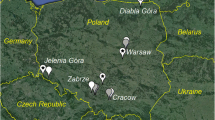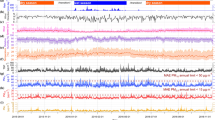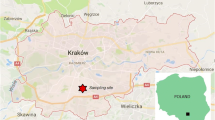Abstract
Purpose
This study was aimed to the development of an integrated approach for the characterization of particulate matter (PM) pollution events in the South of Italy.
Methods
PM10 and PM2.5 daily samples were collected from June to November 2008 at an urban background site located in Bari (Puglia Region, South of Italy). Meteorological data, particle size distributions and atmospheric dispersion conditions were also monitored in order to provide information concerning the different features of PM sources.
Results
The collected data allowed suggesting four indicators to characterize different PM10 exceedances. PM2.5/PM10 ratio, natural radioactivity, aerosol maps and back-trajectory analysis and particle distributions were considered in order to evaluate the contribution of local anthropogenic sources and to determine the different origins of intrusive air mass coming from long-range transport, such as African dust outbreaks and aerosol particles from Central and Eastern Europe. The obtained results were confirmed by applying principal component analysis to the number particle concentration dataset and by the chemical characterization of the samples (PM10 and PM2.5).
Conclusions
The integrated approach for PM study suggested in this paper can be useful to support the air quality managers for the development of cost-effective control strategies and the application of more suitable risk management approaches.







Similar content being viewed by others
References
Amodio M, Bruno P, Caselli M, de Gennaro G, Dambruoso PR, Daresta BE, Ielpo P, Gungolo F, Placentino CM, Paolillo V, Tutino M (2008) Chemical characterization of fine particulate matter during peak PM10 episodes in Apulia (South Italy). Atmos Res 90:313–325
Amodio M, Andriani E, Cafagna I, Caselli M, Daresta BE, de Gennaro G, Di Gilio A, Placentino CM, Tutino M (2010a) A statistical investigation about sources of PM in South Italy. Atmos Res 98:207–218
Amodio M, Andriani E, Caselli M, Dambruoso PR, Daresta BE, de Gennaro G, Ielpo P, Placentino CM, Tutino M (2010b) Characterization of particulate matter in the Apulia Region (South of Italy): features and critical episodes. J Atmos Chem 63:203–220
Amodio M, Andriani E, Angiuli L, Assennato G, de Gennaro G, Di Gilio A, Giua R, Intini M, Menegotto M, Nocioni A, Palmisani J, Perrone MR, Placentino CM, Tutino M (2011) Chemical characterization of PM in Apulia Region: local and long-range transport contributions to particulate matter. Boreal Env Res 16:251–261
Andriani E, Caselli M, Ielpo P, de Gennaro G, Daresta BE, Fermo P, Piazzalunga A, Placentino MC (2010) Application of CMB model to PM10 data collected in a site of South Italy: results and comparison with APCS model. Curr Anal Chem 6:19–25
Andriani E, Caselli M, de Gennaro G, Giove A, Tortorella C (2011) Synergistic use of several receptor models (CMB, APCS and PMF) to interpret air quality data. Environmetrics 22:789–797
Birch ME, Cary RA (1996) Elemental carbon-based method for monitoring occupational exposures to particulate diesel exhaust. Aerosol Sci Technol 25:221–241
Calvello M, Esposito F, Pavese G, Serio C (2010) Physical and optical properties of atmospheric aerosols by in-situ and radiometric measurements. Atmos Chem Phys 10:2195–2208
de Gennaro G, Amodio M, Andriani E, Dambruoso PR, Demarinis Loiotile A, Di Gilio A, Trizio L (2011) Optical properties of atmospheric aerosols in Abulia Region (South of Italy) PM Exceedances. 13th EuCheMS International Conference on Chemistry and the Environment 2011:ATMO P3 (281)
Directive 2008/50/EC of the European Parliament and of the Council of 21 May 2008 on ambient air quality and cleaner air for Europe
Englert N (2004) Fine particles and human healt—a review of epidemiological studies. Toxicol Lett 149:235–242
Escudero M, Querol X, Avila A, Cuevas E (2007) Origin of the exceedances of the European daily PM limit value in regional background areas of Spain. Atmos Environ 41:730–744
Forbes L, Patel MD, Rudnicka AR, Cook DG, Bush T, Stedman JR, Strachan DP, Anderson HR (2009) Chronic exposure to outdoor air pollution and diagnosed cardiovascular disease: meta-analysis of three large cross-sectional surveys. Environ Health 8(30)
Glavas SD, Nikolakis P, Ambatzoglou D, Mihalopoulos N (2008) Factors affecting the seasonal variation of mass and ionic composition of PM2.5 at a central Mediterranean coastal site. Atmos Environ 42:5365–5373
Harrison RM, Misibi MI, Kitto AMN, Yamulki S (1994) Atmospheric chemical transformations of nitrogen compounds measured in the North Sea experiment, September 1991. Atmos Environ 28:1593–1599
Hayami H (2004) Behavior of secondary inorganic species in gaseous and aerosol phases measured in Fukue Island, Japan, in dust season. Atmos Environ 39:2243–2248
Hellebust S, Allanic A, O'Connor IP, Wenger JC, Sodeau JR (2010) The use of real-time monitoring data to evaluate major sources of airborne particulate matter. Atmos Environ 44:1116–1125
Henry RC, Lewis CW, Hopke PK, Williamson HJ (1984) Review of receptor model fundaments. Atmos Environ 18:1507–1515
Huang Z, Harrison RM, Allen AG, James JD, Tilling RM, Yin J (2004) Field intercomparison of filter pack and impactor sampling for aerosol nitrate, ammonium, and sulphate at coastal and inland sites. Atmos Res 71:215–232
Manigrasso M, Abballe F, Jack RF, Avino P (2010) Time-resolved measurement of the ionic fraction of atmospheric fine particulate matter. J Chromatogr Sci 48:549–553
Mazzei F, Lucarelli F, Nava S, Prati P, Valli G, Vecchi R (2007) A new methodological approach: the combined use of two-stage streaker samplers and optical particle counters for the characterization of airborne particulate matter. Atmos Environ 41:5525–5535
Meloni D, di Sarra A, Monteleone F, Pace G, Piacentino S, Sferlazzo DM (2008) Seasonal tran sport patterns of intense Saharan dust events at the Mediterranean Island of Lampedusa. Atmos Res 88:134–148
Nadadur SS, Miller A, Hopke PK, Gordon T, Vedal S, Vandenberg JJ, Costa DL (2007) The complexities of air pollution regulation: the need for an integrated research and regulatory perspective. Toxicol Sci 100:318–327
Pakkanen TA (1996) Study of formation of coarse particle nitrate aerosol. Atmos Environ 30:2475–2482
Pant P, Harrison RM (2011) Critical review of receptor modelling for particulate matter: a case study of India. Atmos Environ. doi:10.1016/j.atmosenv.2011.11.060
Perez N, Pey J, Querol X, Alastuey A, Lopez JM, Viana M (2008) Partitioning of major and trace components in PM10–PM2.5–PM1 at an urban site in Southern Europe. Atmos Environ 42:1677–1691
Perrino C, Catrambone M, Pietrodangelo A (2008) Influence of atmospheric stability on the mass concentration and chemical composition of atmospheric particles: a case study in Rome, Italy. Environ Int 34:621–628
Perrino C, Canepari S, Catrambone M, Dalla Torre S, Rantica E, Sargolini T (2009) Influence of natural events on the concentration and composition of atmospheric particulate matter. Atmos Environ 43:4766–4779
Pope CA, Ezzati M, Dockery DW (2009) Fine-particulate air pollution and life expectancy in the United States. N Engl J Med 360:376–386
Querol X, Alastuey A, Rodriguez S, Plana F, Ruiz CR, Cots N, Massaguè G, Puig O (2001) PM10 and PM2.5 source apportionment in the Barcelona Metropolitan area, Catalonia, Spain. Atmos Environ 35:6407–6419
Querol X, Alastuey A, Rodríguez S, Viana MM, Artíñano B, Salvador P, Mantilla E, Santos SGD, Patier RF, Rosa JDL, Campa ASDL, Menéndez M (2004) Levels of PM in rural, urban and industrial sites in Spain. Sci Total Environ 334–335:359–376
Reich BJ, Fuentes M, Burke J (2009) Analysis of the effects of ultrafine particulate matter while accounting for human exposure. Environmetrics 20:131–146
Ruuskanen J, Tuch Th, Brink HT, Peters A, Khlystov A, Mirme A, Kos GPA, Brunekreef B, Wichmann HE, Buzorius G, Vallius M, Kreyling WG, Pekkanen J (2001) Concentrations of ultrafine, fine and PM2.5 particles in three European cities. Atmos Environ 35:3729–3738
Sager TM, Castranova V (2009) Surface area of particle administered versus mass in determining the pulmonary toxicity of ultrafine and fine carbon black: comparison to ultrafine titanium dioxide. Part Fibre Toxicol 6:15–46
Zanobetti A, Schwartz J (2005) The effect of particulate air pollution on emergency admissions for myocardial infarction: a multicity case-crossover analysis. Environ Health Perspect 113:978–982
Zhuang H, Chan CK, Fang M, Wexler AS (1999) Formation of nitrate and non-sea-salt sulfate on coarse particles. Atmos Environ 33:4223–4233
Acknowledgements
This study was carried out in the framework of the project ‘Integrated System for the Monitoring of the Atmospheric Particulate (SIMPA)’ financed by the Puglia Region. The authors wish to thank Lenviros srl (Bari, Italy) for the invaluable co-operation and for the support in the sampling campaign. The authors are also grateful to FAI Instruments srl (Rome, Italy) for the assessment of the monitoring station and for the effective technical assistance.
Author information
Authors and Affiliations
Corresponding author
Additional information
Responsible editor: Philippe Garrigues
Electronic supplementary material
Below is the link to the electronic supplementary material.
ESM 1
(DOC 47 kb)
Rights and permissions
About this article
Cite this article
Amodio, M., Andriani, E., de Gennaro, G. et al. An integrated approach to identify the origin of PM10 exceedances. Environ Sci Pollut Res 19, 3132–3141 (2012). https://doi.org/10.1007/s11356-012-0804-5
Received:
Accepted:
Published:
Issue Date:
DOI: https://doi.org/10.1007/s11356-012-0804-5




